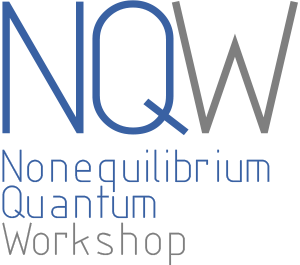
- This event has passed.
Non-equilibrium transport and quantum information jet in the Hubbard model
December 11, 2023 @ 11:15 - 11:45 CET
M.A. Werner,1,2,3 C.P. Moca,2,4 P. Penc,1,2 M. Kormos,1,2
A. Valli,1,2 Ö. Legeza,3 T. Prosen,5 G. Zarand1,2
1Department of Theoretical Physics, Institute of Physics, Budapest University of Technology and Economics, Budafoki u ́t 8., H-1111 Budapest, Hungary
2HUN-REN–BME Quantum Dynamics and Correlations Research Group, Budapest University of Technology and Economics, Műegyetem rkp. 3., H-1111 Budapest, Hungary
3Strongly Correlated Systems Lendulet Research Group, Wigner Research Centre for Physics, H-1525, Budapest, Hungary
4Department of Physics, University of Oradea, 410087, Oradea, Romania
5Department of Physics, Faculty of Mathematics and Physics, University of Ljubljana, Jadranska 19, SI-1000 Ljubljana, Slovenia
In this presentation, I focus on the impact of interaction and symmetries on non-equilibrium charge and spin transport in the Hubbard model. The structure of non-equilibrium dynamics is found to change dramatically upon increasing interaction [1-4]. In usual quench experiments, a relatively standard Fermi liquid-like behavior appears for small interactions, while phenomena such as composite particle formation along with negative temperature states emerge for larger interactions [1].
The properties of the infinite temperature state depend crucially on symmetries. At half-filling, he SU(2) Hubbard model exhibits global SUc(2)⊗SUs(2) symmetry, and there Kardar-Parisi-Zhang (KPZ) scaling is observed in charge and spin correlations and transport [2]. Away from half-filling, however, the SUc(2) charge symmetry is reduced to Uc(1), while the SUs(2) symmetry for the total spin is retained. Consequently, transport in the charge sector becomes ballistic, while KPZ scaling is preserved in the spin sector. The anomalous diffusion coefficient is found to scale as 1/U at large U.
In the presence of localized particle loss at the end of a semi-infinte chain, we observe a ballistic current front propagation with strongly renormalized front velocity, and a hydrodynamic current density profile. Operator entanglement is found to propagate faster than the depletion profile, preceding the latter [3], and a mutual information jet appears that propagates with a velocity independent of U. While the slow front can be captured by a cellular automaton model and carries classical correlations, the fast mutual information front appears to have a quantum-mechanical nature, and persists at infinite temperature and interaction.
- M.A. Werner, C.P. Moca, M. Kormos, Ö. Legeza, B. Dóra, G. Zaránd, Spectroscopic evidence for engineered hadron formation in repulsive fermionic SU(N) Hubbard Models, Phys. Rev. Research 5, 043020 (2023)
- C.P. Moca, M.A. Werner, A. Valli, T. Prosen, G. Zaránd, Kardar-Parisi-Zhang scaling in the Hubbard model, Phys. Rev. B, in print [arXiv:2306.11540]
- C.P. Moca, M.A. Werner, Ö. Legeza, T. Prosen, M. Kormos, G. Zaránd, Simulating Lindbladian evolution with non-abelian symmetries: Ballistic front propagation in the SU(2) Hubbard model with a localized loss, Phys. Rev. B 105, 195144 (2022)
- P. Penc, C.P. Moca, T. Prosen, G. Zaránd, M.A. Werner, Quantum-information jet in the infinite temperature Hubbard model, unpublished


